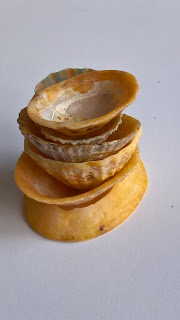Cloud Arc by Roger Ackling was made by burning marks in cardboard using a magnifying glass.No sooner had I thought of the link to Meteorological suncards when there were examples on display!
Before the weather station at Kew Gardens was updated to digital ecording , one of the daily duties of the weather recorder was to change the suncards (differerent shaped formats were used at different times of year) At one time I did this on a regular basis , climbing up a precipitous ladder to the roof of the building rewarded with excellent views. The 'crystal ball' gave beautiful distorted reflections of the surroundings and sky. The highest temperature recorded in the UK was held briefly by Kew before it was confirmed as being higher at Brogdale. My colleague who recorded it was on weekend duty in a tropical glasshouse ! - I was at home finishing off a quilt ( a fan and lots of ice were essential equipment). But I digress...


Series of photographs or stills from a film record the changes in movement of the sun in sun tunnels in this work by Nancy Holt ( above) and of the actions of the tide filling a flexiglass cylinder ( giving the illusion of a hole in the sea ) by Barry Flanagan
Processes of drawing can seem deceptively simple ( Nakahara Nantenbo, above) or intricately complex multilayered 'sea tracings' by Trevor Shearer ( below)
I loved the marks of this site-specific circle by Richard Long and how being outside, the shadows constantly change
This stack of tiny black porcelain vessels' Littoral' by Edmund de Waal made me think a stack of stones or shells on a beach so I collected some limpets and drew them when I got home !
Some circles noted on our way back to the station - my gathering continues



























































